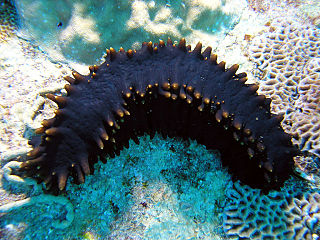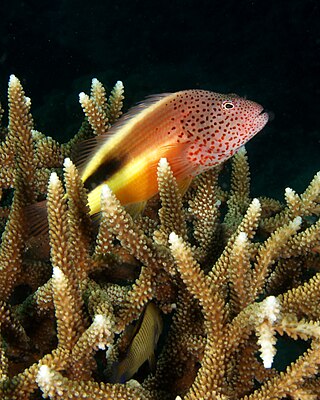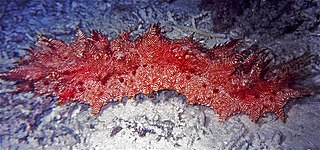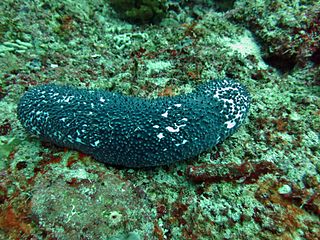
Actinopyga is a genus of sea cucumbers found in coastal waters in tropical and temperate regions.

Holothuria atra, commonly known as the black sea cucumber or lollyfish, is a species of marine invertebrate in the family Holothuriidae. It was placed in the subgenus Halodeima by Pearson in 1914, making its full scientific name Holothuria (Halodeima) atra. It is the type species of the subgenus.

Stichopus chloronotus is a species of sea cucumber. Common names include the greenfish sea cucumber, the spiky sea cucumber and the black knobby sea cucumber. It is native to the Indo-Pacific region. It has a wide range and is abundant and the IUCN lists it as being of "Least Concern".

Pearsonothuria is a genus of sea cucumbers in the family Holothuriidae. Pearsonothuria graeffei is the only species in the genus. Graeffe's sea cucumber is found in the tropical Indo-Pacific Ocean and the type locality is Viti Island, Fiji. It is named after Eduard Heinrich Graeffe, Semper's coworker at the Museum Godeffroy.

Acropora grandis is a species of colonial stony coral. It is a large species with multiple branches forming a bush-like structure and is found on reefs and in lagoons. It is native to the tropical western Indo-Pacific and has a range extending from East Africa to the east coast of Australia.

Holothuria edulis, commonly known as the edible sea cucumber or the pink and black sea cucumber, is a species of echinoderm in the family Holothuriidae. It was placed in the subgenus Halodeima by Pearson in 1914, making its full scientific name Holothuria (Halodeima) edulis. It is found in shallow water in the tropical Indo-Pacific Ocean.

Actinopyga echinites, commonly known as the brownfish or deep water redfish, is a species of sea cucumber in the family Holothuriidae. It is native to the tropical Indo-Pacific region and is harvested for food.

Thelenota rubralineata is a species of sea cucumber in the family Stichopodidae, in the phylum Echinodermata, mainly located in the central Indo-Pacific region. It has a distinctive coloring pattern, and can be found on the seabed near coral. T. rubralineata is a member of the Thelenota genus, characterized by their large size and the presence of a calcareous ring.

Holothuria fuscocinerea, the ashy pink sea cucumber, is a species of sea cucumber in the family Holothuriidae. It is placed in the subgenus Stauropora, making its full name Holothuria (Stauropora) fuscocinerea. It is native to shallow water in the tropical and sub-tropical Indo-Pacific.

Holothuria fuscopunctata, the elephant trunkfish, is a species of sea cucumber in the family Holothuriidae native to shallow water in the tropical Indo-Pacific. It is placed in the subgenus Microthele, making its full name Holothuria (Microthele) fuscopunctata.

Actinopyga caerulea, the blue sea cucumber, is a species of sea cucumber in the family Holothuriidae. Named for its unique blue coloration, this species can be found along the continental shelf of the tropical Western Indo-Pacific region, at depths between 12 and 45 m. It is a commercially important species, and is harvested for food along its range.

Actinopyga mauritiana, commonly known as the surf redfish, is a species of sea cucumber in the family Holothuriidae. It is native to the tropical West Indo-Pacific region and is harvested for food.

Labidodemas rugosum is a species of sea cucumber in the family Holothuriidae. It is native to the tropical Indo-Pacific region.

Actinopyga miliaris, commonly known as the hairy blackfish, is a species of sea cucumber in the family Holothuriidae. It is native to the tropical West Indo-Pacific region and is harvested for food.

Actinopyga lecanora, commonly known as the white-bottomed sea cucumber or stonefish, is a species of sea cucumber in the family Holothuriidae. It is native to the tropical Western Indo-Pacific region and is harvested for food.
The Dr. K.K. Mohammed Koya Sea Cucumber Conservation Reserve is a marine protected area located off the coast of the Indian union territory of Lakshadweep, approximately 50 km (31 mi) northwest of the island of Bitra. Formally established by Indian authorities on February 27th, 2020, the reserve covers 239 km2 (92 sq mi) of the Arabian Sea, including parts of the Byramgore (Cheriyapani) Reef, and is the world's first conservation area specifically dedicated to the protection of sea cucumbers.
Holothuria lessoni, the golden sandfish, is a species of sea cucumber in the genus Holothuria, subgenus Metriatyla. This sea cucumber inhabits the shallow waters of the Indo-Pacific Ocean, where it is found near islands and reef flats. It is highly sought after in commercial and subsistence fishing and the species threatened by overfishing.

Actinopyga varians, the Pacific white-spotted sea cucumber or Hawaiian sea cucumber, is a species of sea cucumber in the family Holothuriidae. It is found in the Pacific Ocean near Hawaii and also in the Indo-Pacific Ocean.
Actinopyga fusca is a species of sea cucumber in the family Holothuriidae. It is endemic to the shallow coastal waters of New Caledonia, particularly around the island of Ilot Maître.
Actinopyga palauensis, the Panning's blackfish, is a species of sea cucumber within the family Holothuriidae. The species distribution is in the western Pacific near areas such as Palau, the Federated States of Micronesia, Tonga, Niue, eastern Australia, and New Caledonia. It lives in reef environments at depths up to 30 meters, often being found crawling on sandy reef slopes, course sand with reef rubble, semi-sheltered bay reefs, and is occasionally found in lagoons and inshore reefs.
















